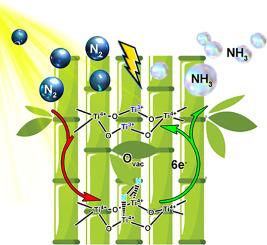Chemical Engineering Journal ( IF 15.1 ) Pub Date : 2020-06-28 , DOI: 10.1016/j.cej.2020.126033 Yuanzheng Zhang , Xiang Chen , Siyao Zhang , Lifeng Yin , Yang Yang

|
Solar-driven nitrogen fixation is a potential solution to satisfying industrial and agricultural demand, but is severely hampered by the difficulties in capturing, activating and cleaving the dinitrogen (N2). Here, the defect TiO2 nanobamboo arrays (DTiO2 NBAs) is designed with an electro-reduction strategy, which, for the first time, successfully converted N2 to ammonia (NH3) in the visible and near infrared light range under ambient conditions, without any sacrificial agent or noble-metal co-catalysts. A highly selective NH3 yield of 48.3 mg m−2 h−1 (178 μmol g−1 h−1, no N2H4 formation) is obtained on the DTiO2 NBAs haired titanium foil. The apparent quantum efficiency (AQE) was measured to be 0.39% at 365 nm, 0.12% at 405 nm, 0.11% at 450 nm, 0.15% at 532 nm, 0.24% at 650 nm, and 0.07% at 780 nm. It is found that the electro-reduction process creates amorphous surface layer with modest oxygen vacancy (Ovac) density so as to greatly enhance light harvesting, charge carrier, photo-thermal effect, as well as nitrogen adsorption and hydrogenation activity. The alternating photo-fixation pathway is also confirmed by density functional theory (DFT) calculations. This novel nanobamboo TiOx architecture shows a potential as a new artificial nitrogen fixation for environmentally friendly NH3 production.
中文翻译:

瑕疵的二氧化钛纳米竹阵列结构,用于高达780 nm的光催化固氮
太阳能驱动的固氮技术是满足工业和农业需求的潜在解决方案,但由于捕获,活化和裂解二氮(N 2)的困难而受到严重阻碍。在这里,缺陷TiO 2纳米竹纤维阵列(DTiO 2 NBAs)采用电还原策略设计,该策略首次在环境条件下在可见光和近红外光范围内成功地将N 2转化为氨(NH 3)。 ,没有任何牺牲剂或贵金属助催化剂。NH 3的高选择性产率为48.3 mg m -2 h -1(178μmolg -1 h -1,无N2 H 4生成)是在DTiO 2 NBAs的有毛钛箔上获得的。表观量子效率(AQE)在365 nm下测量为0.39%,在405 nm下为0.12%,在450 nm下为0.11%,在532 nm下为0.15%,在650 nm下为0.24%,在780 nm下为0.07%。发现电还原过程产生具有适度的氧空位(O vac)密度的非晶态表面层,从而极大地增强了光收集,电荷载流子,光热效应以及氮吸附和氢化活性。交替的光固定路径也通过密度泛函理论(DFT)计算得到证实。这种新颖的纳米竹TiO x结构显示出作为环保NH的新型人工固氮剂的潜力3生产。


























 京公网安备 11010802027423号
京公网安备 11010802027423号